
Reynatis Review
FuRyu has cemented a certain strategy to much of their RPG slate over the last decade or so. Typically, it involves placing renowned creators on a pedestal and centering the newest project around that creator's involvement, at least as far as marketing goes. However, despite getting some flashy names to show off their titles, FuRyu's RPG output itself has left a lot to be desired.
The Caligula Effect brought Tadashi Satomi to helm the scenario, only to leave us with a tedious experience. Monark touted involvement from several key Shin Megami Tensei staff, but resulted in a 'repetitive and dull RPG'. The Alliance Alive, in what may be FuRyu's best offering so far, brought in the late Yoshitaka Murayama to write the narrative and Kyoji Koizumi to handle the systems in SaGa-like RPG. It was ... decisively adequate. Trinity Trigger wasn't very satisfying either, despite involvement from Hiroki Kikuta and Raita Kazama.
This time, for Reynatis, FuRyu is hyping up the involvement of RPG veterans Kazushige Nojima and Yoko Shimomura, known largely for their involvement in Square Enix franchises like Final Fantasy and Kingdom Hearts. Once again, however, FuRyu's offering doesn't quite land well, feeling more like a flimsy imitation than a worthy inspired RPG.

Reynatis is set in an alternate modern-day Shibuya, where some members of the populace gain magical abilities after near-death experiences, labeled as wizards or witches. Reynatis has two primary protagonists: Marin Kirizumi is a college student, and he aims to be the strongest wizard in the world. Sari Nishijima is an officer in a special police force, and her division is tasked with keeping Shibuya's wizard population under control. Due to prejudice against wizards in this society, they mostly keep their abilities secret, which is seemingly done by wearing hoods.
FuRyu's marketing frames Reynatis as a dual-protagonist game, and the game opens up with some toggling between Marin and Sari's groups in between chapters in the game's opening hours. However, by the halfway point, the two parties will coalesce into a relatively standard six-person JRPG team, with Marin clearly centered as the real protagonist of the game.
Reynatis is an action RPG, and combat focuses on a central mode-switching mechanic which is easily the most unique component of the game. In Liberation mode, your character will be on the offensive, dishing out damage while performing attacks and abilities. However, these attacks all cost MP seen in the meter situated at the bottom-center of the user interface. To regain MP, you can switch to Suppression mode, where you cannot deal damage, but you can dodge attacks that come your way to fill your magic meter. Once full, you can switch back to Liberation to continue the offensive onslaught.

I want to be clear, dodging attacks in Suppression mode is more than just moving your character out of the way of enemy attacks. Instead, if you wait and let enemy attacks come close to landing, a QTE-like circle will appear. If you press & hold the dodge button with proper timing, you'll avoid the attack. If you are situated a proper distance from the enemy, you'll also fill a bit of your MP meter. So, the idea is to dodge a few attacks via QTE, regain your MP, and then go back into Liberation mode to continue dealing damage. If you let your magic meter fill to full before switching back, you'll do a magic burst, where time slows down temporarily.
In Liberation mode, those QTE dodge circles will not appear as they do in Suppression mode. It's also important to note that certain attacks cannot be dodged in this way, as indicated by a purple glow. So you have to pay attention to the types of attacks coming your way, know what times to be in what mode, and know if you have to get out of the way of an attack, or not.
So, there's this sort of off-and-on cadence as you switch between dodge and attack modes, and it can work well at times in spurts. However, it doesn't always feel good, and the implementation is not always ideal. There were numerous times I ran out of MP, so I had to sit around passively waiting for enemies to attack once, twice, or more to fill up the gauge. In normal battles, this can sometimes take several seconds to do, which can be tedious when the enemy is not at all threatening. In fact, sometimes regular battles can feel a bit boring as you have to cater to the enemy attack pattern a few times just so you aren't MP-empty. Still, early on, this manner of mode switching works fine, if a bit uninteresting.
What also leads combat to feel stale, at times, is the limited number of attack actions available. While each character in the game eventually unlocks several attack abilities that they can use, strangely, you can only equip two of these at a time. This means, effectively, attacking an enemy involves, slamming the attack button a few times, launching your attack ability, repeating once and again until you run out of MP, then switching to Suppression mode. While some timing is involved in mode switching and QTE dodging, attacking feels mostly like button mashing.
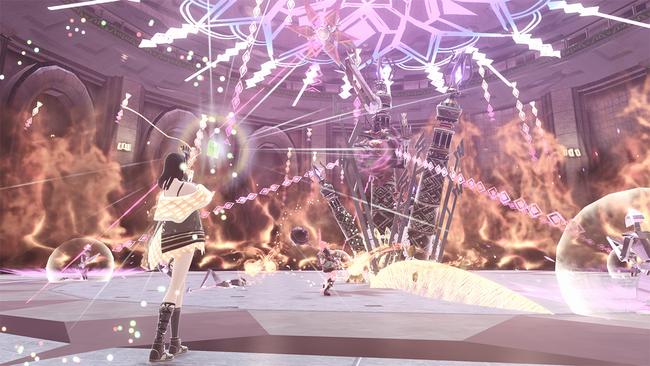
Boss fights are a little strange, but for the opposite reason. By the halfway point in the game, this focus on dodging in Suppression mode gets somewhat chaotic. Many bosses in the game rely on multiple parts using multiple attacks, nearly at all times. You'll have attacks coming from all directions: lasers, shockwaves, punches, etc; most importantly, there will be attacks that you can dodge mixed in with attacks you cannot dodge, and so it becomes more and more difficult to switch modes at the right time and dodge the rights attacks (and not the wrong attacks). In some boss fights, the screen becomes a visual mess of projectiles and effects.
I eventually decided that trying to dodge the majority of attacks in Suppression Mode efficiently was not worth it, in the end. Succinctly, combat in boss fights sometimes gets too chaotic to try and be perfect with dodging, even though it's a key component of the combat design. So, what I did instead is that I would dodge enough attacks to fill my MP meter, and then I'd use a magic burst to go in on the offensive when I could. This meant I would eat damage that I couldn't dodge this way, but I made up for it by downing consumable items to keep up my health. It was an effective strategy, but messy and a little bit annoying. I feel like for the mode-switching mechanic to be most successful, boss attack patterns should be more deliberate rather than the mayhem they often end up becoming.
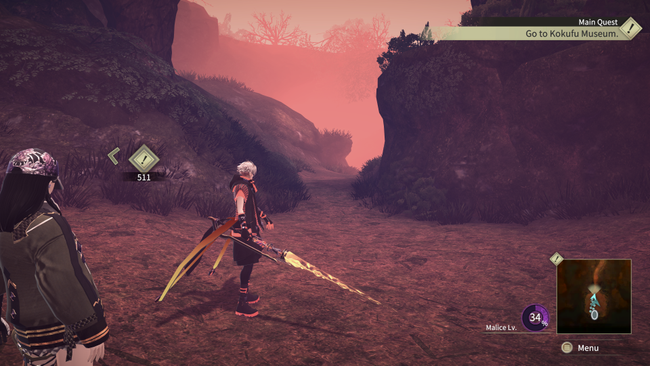
While Shibuya is the central location in Reynatis, much of the game's traversal takes place outside of the city. Unfortunately, these locations, for the most part, take place in repetitive forest areas, which essentially amount to a single pathway and a few dedicated battle areas dotted along the way. Sometimes there might be a branching path that goes to a small dead end, or sometimes there's a small branching path that loops back to the main path, but these are effectively linear zones. While the color of the fog might change, these locations themselves do not change in any practical way, and you'll have to travel through these paths many times before you hit the end credits. They are a little bit dull both aesthetically and functionally.
Other supporting sub-systems in the game are quite basic. There are sidequests you can pick up from some of the townspeople, but practically all of these quests involve either fighting a few standard enemies or revisiting a location to pick up a key item. There's a system in place where, since wizards are shunned in public, you'll have to go into hiding after fighting out on the streets. This means you either have to run to a dedicated hiding spot, or more effectively, just fast travel to another location (and back, if you need to). Many of these systems feel either thin or undercooked, and there's not much to latch onto.
You can also gain skills and stats by 'examining' graffiti that appears throughout Shibuya as you progress through the game, although there's nothing to it other than clicking it when you see it. If the Shibuya setting wasn't enough on its own, it's clear that The World Ends With You was also a big influence for FuRyu in creating this game.
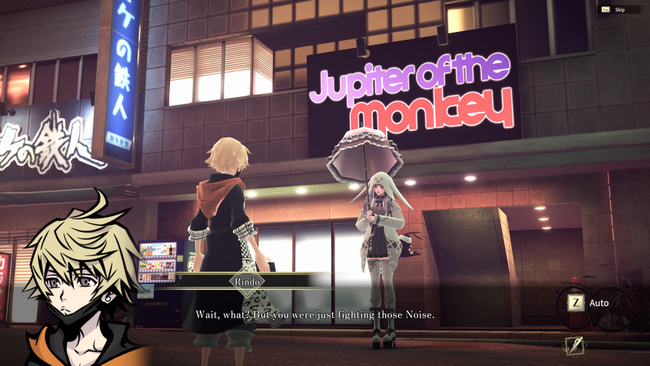
By the way, that NEO: The World Ends With You crossover? It's an isolated, optional event that you can do around the halfway point in the game, taking about 45 minutes to complete. Do you remember those various crossover events in Final Fantasy XV for Terra Battle, Assassin's Creed, or Final Fantasy XIV? It basically feels like one of those. It doesn't tie into the larger narrative, but you do get one additional skill for completing it. I know some people who weren't interested in Reynatis until they saw it had this crossover, so just be aware that the crossover content takes less than 1 hour in a 20-hour title, and it is more-or-less divorced from the rest of the game.
Plainly, Reynatis is kind of an ugly RPG, at least in several places. While some of the pre-rendered cutscenes look nice, in-game characters and animation feel a generation or two removed from modern games. Not only that, several of the environments outside of the city are repetitive and drab.
What might be the best component of Reynatis is the visual recreation of Shibuya, complete with real-world places and businesses. While the character models and animations feel straight out of a PlayStation Vita game, Shibuya itself is a nice-looking environment. It's clear that Reynatis placed a lot of effort in recreating Shibuya in a virtual world, and as far as I can tell, they were successful at this.
As far as Shimomura's soundtrack goes, it mostly sounds like music that wouldn't feel out of place in Kingdom Hearts. My favorite track is actually what plays in Shibuya as an environmental theme, which utilizes low-lying steady rhythmic percussion and piano flourishes.
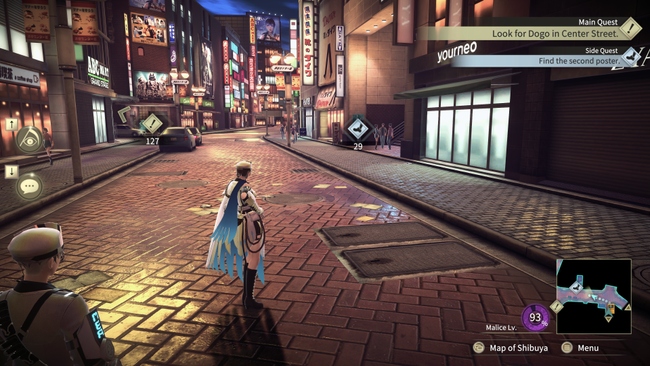
If combat is tedious, sub-systems are thin, and visuals are uneven, then maybe the game's writing, narrative, and characters can do some heavy lifting and offer something unique. However, Reynatis falters here, too.
In several pre-release interviews, FuRyu has discussed theming the game around 'societal pressure' and the inability to express your individuality. These two things, ostensibly, relate to the liberation and suppression modes of the combat. I have to be honest, after completing the game ... I don't see it. Any commentary Reynatis's narrative has about challenging societal norms is superficial at best. Much of the game's character writing revolves around a drug known as rubrum (or colloquially, 'the rub'), addiction to which has become something of an epidemic in Shibuya. I would actually say there's more commentary about drug laws and enforcement than anything else, but even this is shallow.
Elsewhere pre-release, FuRyu discussed defining 'the ultimate chūnibyō', which is probably a better framing of the narrative that actually takes place in Reynatis. Marin spends most of the game's runtime talking about his quest to 'become the strongest', and for the most part, this goal is played completely straight. He wants to be the strongest, and eventually, his allies also want him to be the strongest. Of course, a little bit of friendship magic also works its way into the narrative, but it's hard to say it's anything compelling. In fact, I found myself bored of the narrative through most of the way through.
As you might expect, as you approach the endgame, world-altering stakes come into play and Marin finds himself at the center of it all, but it's relatively typical to JRPGs you've played before. As an aside, a not-insignificant portion of the narrative also places half the cast in deadly bomb-collars for ... comedic effect? It's a strange gag that lasts far longer than I expected it to.
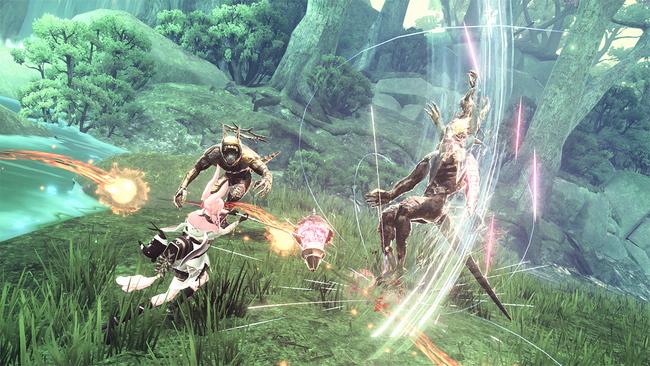
Reynatis is, unfortunately like many other titles in FuRyu's catalog, an underwhelming RPG. In fact, FuRyu has continued to provide a good case study on why we probably shouldn't solely deify individual creators without acknowledging the full ensembles required to make beloved games. But as it is, we're left with an RPG that is average at best, messy & forgettable at worst. I've played most of FuRyu's output, continuing to look for a game that I can easily recommend to fans of the genre. While some games have been better than others, Reynatis doesn't break through the mediocrity. Maybe next time.